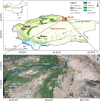Spatiotemporal changes in fine particulate matter and ozone in the oasis city of Korla, northeastern Tarim Basin of China
- PMID: 38839810
- PMCID: PMC11153575
- DOI: 10.1038/s41598-024-63856-5
Spatiotemporal changes in fine particulate matter and ozone in the oasis city of Korla, northeastern Tarim Basin of China
Abstract
Air pollution is a serious environmental health concern for humans and other living organisms. This study analyzes the spatial and temporal characteristics of air pollutant concentrations, changes in the degree of pollution, and the wavelet coherence of the air quality index (AQI) with pollutants in various monitoring stations. The analysis is based on long-term time series data (January 2016 to December 2023) of air pollutants (PM2.5, PM10, and O3) from Korla, an oasis city in the northeastern part of the Tarim Basin, China. The concentrations of PM2.5, PM10, and O3 in Korla showed a cyclical trend from 2016 to 2023; PM10 concentrations exhibited all-season exceedance and PM2.5 exhibited exceedance only in spring. PM2.5 and PM10 showed a seasonal distribution of spring > winter > fall > summer; O3 concentrations showed a seasonal distribution of summer > spring > fall > winter. Strong positive wavelet coherence between PM and Air Quality Index (AQI) data series suggests that the AQI data series can effectively characterize fluctuating trends in PM concentrations. Moreover, PM10 levels IV and VI were maintained at approximately 10%, indicating that sand and dust have a substantial influence on air quality and pose potential threats to the health of urban inhabitants. Based on the results of this study, future efforts must strengthen relative countermeasures for sand prevention and control, select urban greening species with anti-pollution capabilities, rationally expand urban green spaces, and restrict regulations for reducing particulate matter emissions within city areas.
Keywords: Desert Oasis Cities; Korla; Ozone; Particulate matter (PM).
© 2024. The Author(s).
Conflict of interest statement
The authors declare no competing interests.
Figures




Similar articles
-
Characteristics and sources of atmospheric pollutants in typical inland cities in arid regions of central Asia: A case study of Urumqi city.PLoS One. 2021 Apr 20;16(4):e0249563. doi: 10.1371/journal.pone.0249563. eCollection 2021. PLoS One. 2021. PMID: 33878117 Free PMC article.
-
First temporal distribution model of ambient air pollutants (PM2.5, PM10, and O3) in Yangon City, Myanmar during 2019-2021.Environ Pollut. 2024 Apr 15;347:123718. doi: 10.1016/j.envpol.2024.123718. Epub 2024 Mar 4. Environ Pollut. 2024. PMID: 38447651
-
Effects of short-term exposure to air pollution on hospital admissions of young children for acute lower respiratory infections in Ho Chi Minh City, Vietnam.Res Rep Health Eff Inst. 2012 Jun;(169):5-72; discussion 73-83. Res Rep Health Eff Inst. 2012. PMID: 22849236
-
Spatio-temporal characteristics of air pollutants over Xinjiang, northwestern China.Environ Pollut. 2021 Jan 1;268(Pt A):115907. doi: 10.1016/j.envpol.2020.115907. Epub 2020 Oct 20. Environ Pollut. 2021. PMID: 33120351
-
“The Invisible Made Visible”: Science and Technology.2016 Feb 11. In: Close JP, editor. AiREAS: Sustainocracy for a Healthy City: The Invisible made Visible Phase 1 [Internet]. Cham (CH): Springer; 2016. Chapter 3. 2016 Feb 11. In: Close JP, editor. AiREAS: Sustainocracy for a Healthy City: The Invisible made Visible Phase 1 [Internet]. Cham (CH): Springer; 2016. Chapter 3. PMID: 28590619 Free Books & Documents. Review.
Cited by
-
Synergistic Toxicity of Fine Particulate Matter and Ozone and Their Underlying Mechanisms.Toxics. 2025 Mar 24;13(4):236. doi: 10.3390/toxics13040236. Toxics. 2025. PMID: 40278552 Free PMC article. Review.
References
-
- Lu Z, Zhao J, He Q. Concentrations characteristics and sources of particulate matter in Korla, Xinjiang. China. J. Desert. Res. 2022;42(6):74–84. doi: 10.7522/j.issn.1000-694X.2022.00044. - DOI
-
- Yang Z, et al. Investigation into Beijing commuters’ exposure to ultrafine particles in four transportation modes: bus, car, bicycle and subway. Atmos. Environ. 2021;266:118734. doi: 10.1016/j.atmosenv.2021.118734. - DOI
-
- World Health Organization . WHO global air quality guidelines. WHO; 2021.
LinkOut - more resources
Full Text Sources

